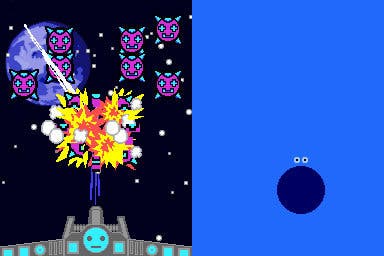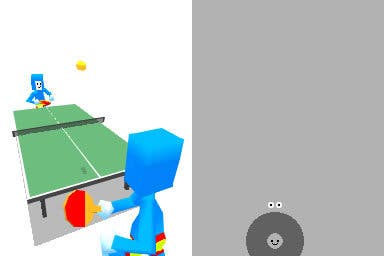Rhythm Tengoku Gold
Drawn to the rhythm.
It'd be worryingly easy to keep doing this. So I will. Easter Island statues, as hinted above, sing along together in a peculiar burping sound, combined with barking like a small dog. Your task is to mirror the sounds made by the, er, male statue (you can tell yours is a girl because she has a stone bow in her hair), with gulls s****ing on your head every time you mess up. Obviously. The animations on their mouths, and their bulging eyes, make it really hard to maintain rhythm for laughing.
Even so, it's not as funny as the hip-bopping frogs. Providing backing dancing for a peculiarly pink frogess, the task is to keep tapping the stylus in time with the tune, such that your frog's hip jiggling doesn't bump the amphibian at his side, all the while keeping up with the twists and flourishes thrown in by audio cues from the singer.
The same sense of smart visual or audio cueing is present once again. During the tutorial you may be taught as many as three or four particular moves, but each will be cued in either by a particular movement or aural clue. It's smart, and it makes sure you're the one who feels stupid when you get it wrong.
Doing well is extremely satisfying, despite the relative simplicity of many of the levels. But of course, while at first it's about unlocking the next one to see what fresh madness lies beyond, it soon becomes about going back and scoring "perfects" on previous levels. While you can pass with a middling performance, the trumpeted wah-wah noise and blue cloud of mediocrity won't sit comfortably with you.

The comparison with Wario Ware is a very helpful one, and it explains something of why, despite its insane joyful fun, Tengoku Gold doesn't win as much of my heart as the GBA's version. Wario Ware Touch never managed to reach the GBA Wario Ware's greatness, seemingly because it was freed from the technical constraints of the simpler machine. When Wario Ware was all about just the one button, the imagination of design was stunning. Given a touch-screen, too much fell into technical thinking rather than pure ingenuity. Something similar seems to have happened here. Just one button to tap forced the game to think damned hard for each of the many levels. Three movement styles dilutes the experience ever so slightly.
However, the descent isn't as sharp as Wario's (Touched dropped to a 7 from Inc.'s 9). While Eurogamer's Keza MacDonald gave the original Tengoku an 8, I would have gone to 9. This game's only a point lower in my mind, and there's a very strong chance it's a point it will make up when the forthcoming English language version appears. Knowing what on earth you're doing, and a simpler route through the very many menus, will be a fantastic experience.

Talking of those menus, as you'd expect from Team Wario Ware, there are many bonus mini-games to unlock, and peculiar extras. A lot are lost in translation, but the bonus mini-games are of course a fresh pleasure. They take the emphasis away from being accurate within a confined time limit, and instead focus on reaching high scores. A particular favourite is the coin-flipping game, which relies on your own timing by gradually removing the metronomic background noise, making it tougher and tougher to know when to catch.
So there it is. Apply that same sense of curiosity and intrigue you had when first hearing about Wario Ware - remember how people said, "I don't get how a collection of three second games can work"? And how wrong that was? The same goes for a collection of minute-long rhythm games based on deeply odd ideas. Synchronised swimmers are of course aided by underwater dolphins. Two scientists throwing and catching conical flasks are of course mixing red and blue hearts for the box of purple hearts on the table. Ghosts? They're in a rock band, dummy.
